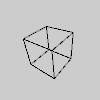camera()#
Sets the position of the camera through setting the eye position, the center of the scene, and which axis is facing upward.
Examples#

def setup():
py5.size(100, 100, py5.P3D)
py5.no_fill()
py5.background(204)
py5.camera(70.0, 35.0, 120.0, 50.0, 50.0, 0.0, 0.0, 1.0, 0.0)
py5.translate(50, 50, 0)
py5.rotate_x(-py5.PI/6)
py5.rotate_y(py5.PI/3)
py5.box(45)
Description#
Sets the position of the camera through setting the eye position, the center of the scene, and which axis is facing upward. Moving the eye position and the direction it is pointing (the center of the scene) allows the images to be seen from different angles. The version without any parameters sets the camera to the default position, pointing to the center of the display window with the Y axis as up. The default values are camera(width//2.0, height//2.0, (height//2.0) / tan(PI*30.0 / 180.0), width//2.0, height//2.0, 0, 0, 1, 0). This function is similar to glu_look_at() in OpenGL, but it first clears the current camera settings.
Underlying Processing method: camera
Signatures#
camera() -> None
camera(
eye_x: float, # x-coordinate for the eye
eye_y: float, # y-coordinate for the eye
eye_z: float, # z-coordinate for the eye
center_x: float, # x-coordinate for the center of the scene
center_y: float, # y-coordinate for the center of the scene
center_z: float, # z-coordinate for the center of the scene
up_x: float, # usually 0.0, 1.0, or -1.0
up_y: float, # usually 0.0, 1.0, or -1.0
up_z: float, # usually 0.0, 1.0, or -1.0
/,
) -> None
Updated on March 06, 2023 02:49:26am UTC
